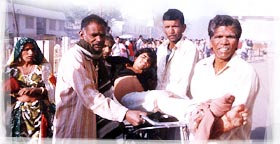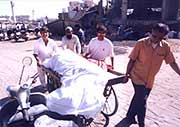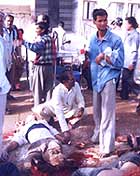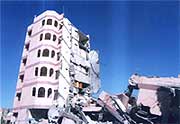The Rediff Special/ Ramesh Menon


The people of Gujarat have always prided themselves on their strong sense of community. It is this feeling, they believe, that helps them though any calamity. It is this feeling, now, that the people of Gujarat depend on. Even their government talks of the great Gujarati spirit that will help the thousands of affected families to rise above the tragedy.
That, sorrowfully, is all it talks about. For the Gujarat government has still to get its act together -- its attempts at relief and rescue have too many gaping holes. Even today, seven days after the devastating quake, relief operations in the state are being spearheaded by social and non-government organisations and foreign bodies.
Roving Editor Ramesh Menon attempts to find out why the Gujarat government has failed in this hour of need.
There was no one to pick up the rotting corpses, so we did it ourselves," says Ramanbhai Gajjar, a Bhuj resident. "We had to use our own hands, otherwise an epidemic will hit us next." It is difficult to find help, he says, as everyone is fleeing Bhuj. Besides, the continuing tremors and lack of infrastructure does not help matters much.
 A group of sadhus from the Swaminarayan sect, who travelled to Bhuj to help the quake's victims, were stunned by the enormity of the tragedy. They immediately prepared a plan of action that focused on the region's urgent needs. The first thing they decided to bring in were tents and food. "But we were determined not to waste anything," says Swami Bhagwat Priya, who still cannot get over the vast amounts of wasted relief material he has seen.
A group of sadhus from the Swaminarayan sect, who travelled to Bhuj to help the quake's victims, were stunned by the enormity of the tragedy. They immediately prepared a plan of action that focused on the region's urgent needs. The first thing they decided to bring in were tents and food. "But we were determined not to waste anything," says Swami Bhagwat Priya, who still cannot get over the vast amounts of wasted relief material he has seen.
Swami Purshottam Priyadasji, who was in Bachchau, is still reeling from the government's total inaction as far as relief and rescue operations were concerned. "I did not know where to begin or what to do. There were heaps of rotting bodies by the roadside and so many more under the rubble. I am sure some of them were alive, but died because they were not rescued even days after the quake. People were crying for relief. There was relief material lying all around but no one to distribute it. Bales of cloth that had come in from Bombay were lying by the roadsides in huge heaps."
The trucks which brought the bales obviously had to return home. Since there was no one there who could receive the material from them, they just dumped it by the sides of the roads. Other relief material that has been similarly abandoned include medicines, mineral water, food packets and many other essentials.
 Swami Gyandivakar Das says, "We want to assess the needs and systematically work at relief. There are hundreds of villages that have got no relief as no one is going into the interiors."
Swami Gyandivakar Das says, "We want to assess the needs and systematically work at relief. There are hundreds of villages that have got no relief as no one is going into the interiors."
Pravin Patel, a teacher in Ahmedabad, travelled to Morvi district to see how he could help. What he saw there was devastating. Despite the widespread destruction, there was no relief worth the name. Patel raced back to Ahmedabad, organised a truckload of relief material and, within a few hours, drove back to Morvi. It is individual efforts like this that are making a difference in Gujarat.
The problem is not shortage of relief; in fact, in some places, there is too much of it. The problem is that it is not reaching many places, particularly the far-flung areas, that need it desperately. Airports in both Bhuj and Ahmedabad are crowded with relief-laden planes. Lack of coordination there means it takes many hours for the relief to be offloaded. It also clogs the airports since the planes cannot fly away until they are emptied.
Industries Commissioner Kirit Shelat, who is in charge of international assistance, says it is not as easy as it sounds. "One planeload means getting around 20 trucks to pick up the material. At times, there are 15 relief aircraft coming in at the same time. So it does happen that we will take time to clear each aircraft or that relief material will lie around for some time."
According to reports reaching Ahmedabad, there are easily over 150 villages in Kutch itself that still have to receive relief. Instances of villagers looting and fighting over food-laden vehicles are becoming common. In Bhuj, though, there is a glut. There is too much relief material and no takers. No wonder gangs of thieves have entered Kutch to make a killing. Thefts have been reported from so many areas that, in some places, the army is keeping a vigil and not letting outsiders come in.
 "The rich have become poor. The earthquake has been a great equaliser, everyone is now living together with the sky as their roof," says a swami, who was helping carry rotting bodies for cremation. As the days pass, the threat of an epidemic is becoming even more real. "The state government is still to act to ensure an epidemic is averted even before it starts," says Mihir Bhatt, director of the Disaster Mitigation Institute in Ahmedabad.
"The rich have become poor. The earthquake has been a great equaliser, everyone is now living together with the sky as their roof," says a swami, who was helping carry rotting bodies for cremation. As the days pass, the threat of an epidemic is becoming even more real. "The state government is still to act to ensure an epidemic is averted even before it starts," says Mihir Bhatt, director of the Disaster Mitigation Institute in Ahmedabad.
Bhatt adds that there has to be a proper sector coordination in the areas of health, water, shelter, livelihood and food. Those dealing with these areas have to work together if they are to be effective. The only efforts that deserves mention in this context are those spearheaded by the international agencies, UNICEF and DFID. "In the same way," says Bhatt, "relief coordination must be both multi-focal and multi-nodal. The focus should be on having more focal points in different locations, which should be able to accommodate diversity of activities.”
Instead, both Ahmedabad and Gandhinagar are following the old management style of a structured hierarchy.
Their results are there for all to see.
Photographs: Pappu Soneji. Design: Dominic Xavier.
The Complete Coverage | List of earthquake sites
Back to top